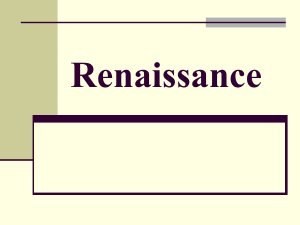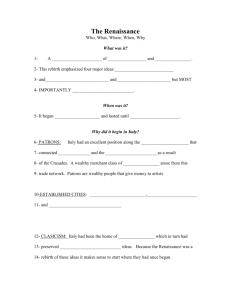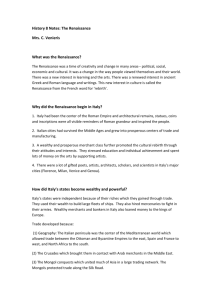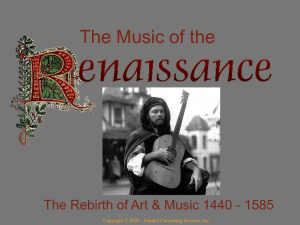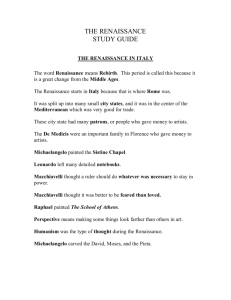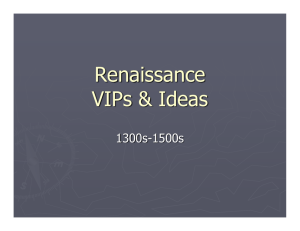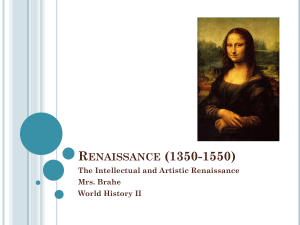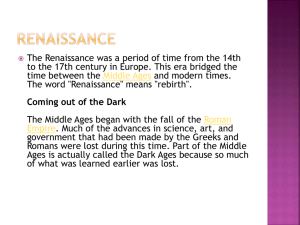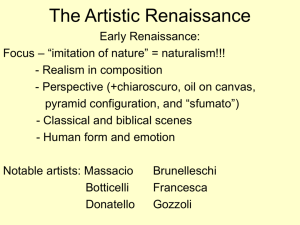Renaissance - McKinney ISD Staff Sites
advertisement
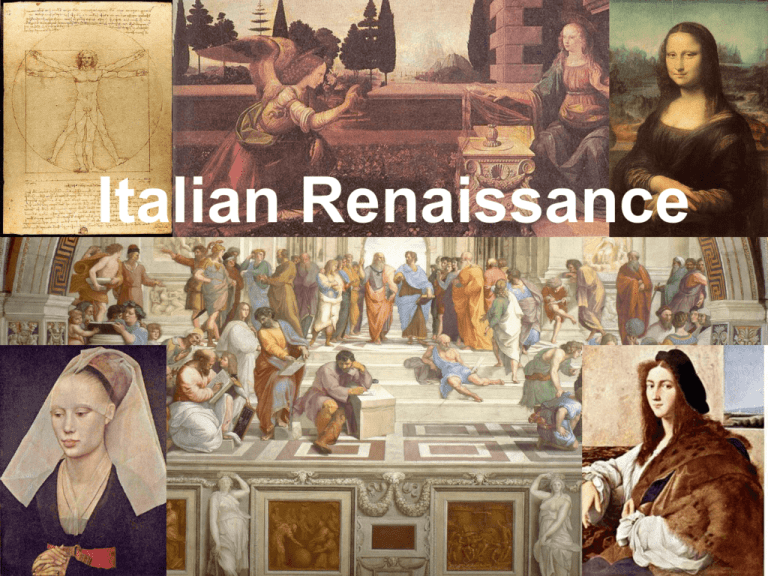
Italian Renaissance Contributions to the end of Medieval Europe • The Crusades – Brought new goods from the East to Europe, stimulating a rebirth in trade, weakened the Byzantine Empire • Black Death – Between 1347 to 1351, 1/3 of population died – Labor shortage: ending of feudalism • Hundred Years’ War – 1337-1453 – War between England/France for claim to French throne • Great Schism – Split of the Catholic Church – Weakened the Church’s authority Begins in Italy • French for “Rebirth” • Growth in the arts and learning. • Began in Italy around 1300 (Florence became the center) • 1. Thriving Cities – Trade from Crusades created a large merchant class – Disease killed 60%-few survivorsdemanded high wages • 2. Wealthy Merchant Class – Italy-city states-run own city-state – Merchants dominated politics • 3. Classical Heritage – Middle ages-no education – Near Roman remains-Art City States • Milan • northernmost – crossroads of main trade routes • Visconti family controls until 1447 • Venice • main link to Asian ports (international power) • controls salt trade • 1st bank • • • • • Florence north-central area de Medici family controls (1434) Ruled through appearance of a government Supported the arts of the time Grandson Richest Lorenzo De Medici Cosimo De Medici Humanism • Intellectual movement in which thinkers studied classical texts and focused on human potential and achievements •Focused on the secular and not the religious. • related to concerns of the world . •Made “the humanities” popular (history, literature, philosophy) •Believed in enjoying the luxuries in life. •Became patrons of the arts to demonstrate the importance of the arts and themselves. •Petrarch: “Father of Humanism” He was important in the recovery of works by writers of ancient Rome and Greece • Erasmus: concentrate on social problems and the reform of the Church, expose the inappropriate behavior of people including the clergy Renaissance Art •Changed from trying to express a religious idea to using a realistic classic style. •Revived old artistic style of Classical Realism, the use of perspective, shadows, more life like •Artists were often painters, sculptors, poets, architects, and inventors. DaVinci Leonardo da Vinci was a “Renaissance man” because of his many talents and interests. He studied art, music, architecture, math and science. Mona Lisa 1503-1506 Musee du Louvre, Paris Last Supper 1494-1498 Santa Maria delle Grazie, Milan Michelangelo • Michelangelo was a sculptor, painter and architect. • Among his famous works are the statue of David and his mural on the ceiling of the Sistine Chapel in the Vatican. Pieta, 1498-1499, St. Peter’s Basilica, Vatican City Raphael • Raphael's art came to represent an ideal of perfection, grace, and harmonious balance. • Raphael produced more than 30 paintings of the Madonna as well as frescos including the “School of Athens.” School of Athens 1509-1511, Apostolic Palace, Vatican City Who is in the School of Athens? Click on link to find out Architecture Medieval Notre Dame Cathedral 1163- 1345 Paris, France Renaissance Era St. Maria Degli Angeli Cathedral 1012-1434 Florence, Italy Renaissance Ideas •Expressed humanist ideas, scientific knowledge, realistic experiences, and social conditions. •Niccolo Machiavelli’s book The Prince said People are selfish, fickle and corrupt. It is better to be feared than respected. Political effectiveness was more important than morals The end justifies the means Northern Renaissance •Ideas were spread to Northern Europe through trade, travel, and print. •The Renaissance inspired social reform. •Artists studied in Italy and would bring the Renaissance style back with them to Europe. Science and Technology • Nicolas Copernicus 1473-1453 – Earth orbited the sun • Galileo Galilei 15641642 – Observations with one of the first telescopes strengthened Copernicus’ Theory – Charges brought against Galileo by the Catholic Church Printing Press • Johann Gutenberg, 1450 • Effects of Printing Press – 1. produce hundreds of copies and circulate – 2. books are now cheaper – 3. 1st book printed was the Bible – 4. Learning and literacy rose significantly. Elizabethan Age • Renaissance in England also known as the Elizabethan Age. • Queen Elizabeth I spoke 4 languages, wrote poetry, patronized writers and artists. • Created a strong, centralized monarchy based on national unty and a sharing power between monarchy & Parliament
